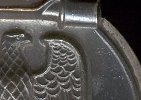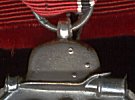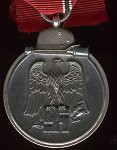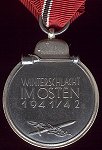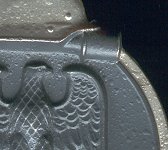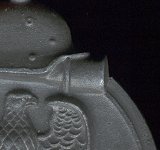
by Sebastián Bianchi
Commonly Known as "Ostmedaille" (East Medal) or "Russian Front Medal" this award was introduced on the 26th of May 1942 to recognize those who participated in the first winter of Operation Barbarossa (the invasion of the Soviet Union). The mammoth endeavor to attain "living space in the east" for Germany employed over 3 million men separated into 3 Army groups; North (Leeb), Center (Bock), and South (Rundstedt). On June 22nd the German forces crossed the border achieving almost complete surprise and with a powerful punch broke into the heart of the Soviet Union. Despite its initial success, however, this Blitzkrieg would not deliver a quick victory and as summer months passed the fighting only intensified. The end of autumn brought a bitterly cold Russian winter which caught the invasion force unprepared and turned the elements into an enemy as dangerous as the Soviets.
Created by SS Unterschrfuhrer Ernst Krauit, the Eastern Medal was to commemorate those who endured these freezing and challenging months. The award is far from rare in the collector's world owing to the fact that 3 million were issued and countless more manufactured. This large scale production yielded a number of variations which are interesting to study.
Manufacturing and Technical Information
The medal features a concave obverse with a helmet and stick grenade immediately below the ribbon loop. Its main obverse feature was a German Eagle holding a swastika, with a branch of leaves behind the swastika. Its convex reverse had the inscription "WINTERSCHLACHT IM OSTEN 1941/42" (Winter Battle in the East) in capital letters with a sword and wreath of leaves crossed under it. The medal measures 44mm (including the ribbon loop) by 36mm.
A plethora of different firms manufactured the award from different metals, making it challenging to categorize the variation. For discussion purposes here they will be broken downs into two categories by the metal used in manufacturing;
- Type 1; Buntmetal
- Type 2; Zinc
What we call here type 1 badges were made from Buntmetal (hard metal) and have stood the test of time better than their zinc counterparts. Surviving examples have generally preserved all the detail and usually preserved most of the finish as well. In fact, they are often found with their finish practically intact making for a visually powerful award. As with any antique, the condition of it also depends on outside factors (storage), and although in some cases the finish has faded off, it is always possible to see a trace of it.
What we categorized as type 2 medals were manufactured from zinc and very often show visible aging signs. Although this type of medal may be occasionally found with a good amount of the finish and detail intact, they are more commonly found with either the "bubbling" that occurs in zinc badges over time or with the finish completely evaporated. In the first case, the zinc has literally bubbled underneath the finish and looks almost like the medal was sprayed with water. In the second case, the finish on the badge has evaporated so long ago and so thoroughly that it gives the impression that it was never there.
If a maker's mark was present it is stamped on the ribbon loop. Below is a list of confirmed manufacturers of the awards and is by no means exhaustive,
| FIRM # | FIRM | LOCATION |
|---|---|---|
| 3 | Wilheim Deumer | Ludenscheld |
| 6 | Fritz Zimmermann | Stuttgart |
| 7 | Paul Meyhauer | Berlin |
| 11 | Grossmann & Co. | Wien |
| 13 | Gustav Brehmer | Markneukirchen/Sa |
| 15 | Friedrich Orth | Wien |
| 20 | C.F. Zimmermann | Pforzheim |
| Arbeitsgemeinschaft der Graveur-Gold-und | Silberschemiede-Innungen | |
| 30 | Hauptmunzamt | Wien |
| 39 | Rudolf Berge | Gablonz a.d.N. |
| 55 | J.E. Hammer & Sohne | Geringswalde |
| 60 | Katz & Deyhle | Pforzheim |
| 65 | Klein & Quenzer A.G. | Idar/Oberstein |
| 76 | Ernst L. Muller | Pforzheim |
| 80 | G.H. Osang | Dresden |
| 88 | Werner Redo | Saarlautern |
| 93 | Richard Simm & Sohne | Gablonz a.d.N. |
| 100 | Rudolf Wachtler & Lange | Mittweida |
| 107 | Carl Wild | Hamburg |
| 127 | Moritz Hausch A.G. | Pforzheim |
| L/55 | Wachtler & Lange Rudolf | Mittwaida/Sa. |
| L/57 | Boerger & Co., | Berlin SO 16 Adalbertstr. 42 |
The medal was suspended by a dark red ribbon with a thin white-black-white stripe. Its foundation decree stated that the red signified the blood shed in the struggle, the white represented the snow, and the black honored the memory of those fallen during the campaign.
Award Criteria
The award was presented to those who met the following criteria during November 15, 1941 and April 26, 1942.
- Fourteen days of combat participation, 30 combat sorties for Luftwaffe pilots.
- Sixty days of service in the combat zone (even if not engaged in actual combat).
- Having received wounds, or frostbite severe enough to warrant a Wound Badge.
In case of death the medal was awarded posthumously and was presented to the next of kin. It was also awarded to German Allies, notably the Italian and Rumanian forces, as well as those volunteers from the invaded Eastern territories who joined the German cause.
For a typical soldier who fought in the Eastern front visit the Eugen Rothenhofer page in the Recipients section of this site.
Presentation and Wear
The medal was presented in a paper envelope which featured the name of the award on the front, with the reverse usually bearing the name of the manufacturer. To my knowledge, this award was never presented in a box or any other device.
Its institution order called for the medal to be worn as part of a group only for official purposes. Active duty personnel would wear only the ribbon from the second button hole in the tunic. This place was normally reserved for the Iron Cross and/or War Merit Cross 2nd class and if any of these awards were also bestowed the recipient could wear both ribbons or place the Eastern Medal on a ribbon bar. Though widely distributed, the Eastern Front Medal was held in high regard and it can sometimes be seen outranking the War Merit Cross 2nd class.
|
lick on image to enlarge |
|
| This Soldbuch picture of Jacob Reis shows him wearing the Eastern Medal in the correct fashion. | |
|
|
|
| This ribbon bar belonging to Karl Rinklef shows the award ( second from the left) in its proper place; after the Iron Cross ribbon but before the long service and Austria Annexation medal. | |
Sebastián Bianchi Collection |
|
Documents
The document style most often encountered is the typical A56+ official style. Since this award was not usually bestowed on the field, typewritten or unofficial documents are very rarely encountered. An entry was made in the appropriate section of the recipient Soldbuch and Wehrpass.
| Click on images to enlarge | |
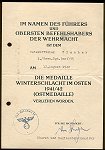 |
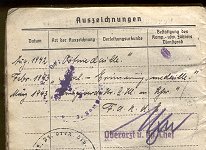 |
| Typical Award document for the Eastern Medal | Soldbuch annotation (August 1942 entry) |
Sebastián Bianchi Collection |
|
By order of the OKW, all considerations for presentation stopped on September 4th, 1944.
Reproductions
Unfortunately for collectors neither the abundance of originals, nor their low price, managed to curb the reproduction of the Eastern award. In this case the relative low cost ensures that the reproductions are truly geared toward reenactors and not for collectors who, for only a few dollars more, could attain a period piece. This does not disqualify the occasional reproductions from seeping through to the collectors ranks, however, but fortunately a large majority of modern strikes lack the detail present in wartime strikes (although manufactured in the millions there is an evident sharpness to original medals).
What one encounters more often than
not is a period medal with a reproduction ribbon. These have a more firm
feel to them and unless intentionally softened to deceive a real collector would
not be confused between a newly sewn ribbon and an original one. Also, an
original ribbon should not fail the "Black
Light Test".
![]()
© Copyright Wehrmacht-Awards.com LLC |
